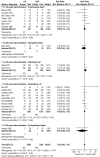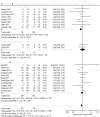Long-acting injectable vs oral antipsychotics for relapse prevention in schizophrenia: a meta-analysis of randomized trials
- PMID: 23256986
- PMCID: PMC3885289
- DOI: 10.1093/schbul/sbs150
Long-acting injectable vs oral antipsychotics for relapse prevention in schizophrenia: a meta-analysis of randomized trials
Abstract
Background: While long-acting injectable antipsychotics (LAIs) are hoped to reduce high relapse rates in schizophrenia, recent randomized controlled trials (RCTs) challenged the benefits of LAIs over oral antipsychotics (OAPs).
Methods: Systematic review/meta-analysis of RCTs that lasted ≥ 6 months comparing LAIs and OAPs. Primary outcome was study-defined relapse at the longest time point; secondary outcomes included relapse at 3, 6, 12, 18, and 24 months, all-cause discontinuation, discontinuation due to adverse events, drug inefficacy (ie, relapse + discontinuation due to inefficacy), hospitalization, and nonadherence.
Results: Across 21 RCTs (n = 5176), LAIs were similar to OAPs for relapse prevention at the longest time point (studies = 21, n = 4950, relative risk [RR] = 0.93, 95% confidence interval [CI]: 0.80-1.08, P = .35). The finding was confirmed restricting the analysis to outpatient studies lasting ≥ 1 year (studies = 12, RR = 0.93, 95% CI:0.71-1.07, P = .31). However, studies using first-generation antipsychotic (FGA)-LAIs (studies = 10, RR = 0.82, 95% CI:0.69-0.97, P = .02) and those published ≤ 1991 (consisting exclusively of all 8 fluphenazine-LAI studies; RR = 0.79, 95% CI: 0.65-0.96, P = 0.02) were superior to OAPs regarding the primary outcome. Pooled LAIs also did not separate from OAPs regarding any secondary outcomes. Again, studies using FGA-LAIs and those published ≤ 1991 were associated with LAI superiority over OAPs, eg, hospitalization and drug inefficacy.
Conclusions: In RCTs, which are less representative of real-world patients than naturalistic studies, pooled LAIs did not reduce relapse compared with OAPs in schizophrenia patients. The exceptions were FGA-LAIs, mostly consisting of fluphenazine-LAI studies, which were all conducted through 1991. Because this finding is vulnerable to a cohort bias, studies comparing FGA-LAI vs second-generation antipsychotics-LAI and LAI vs OAP RCTs in real-world patients are needed.
Keywords: adherence; antipsychotics; depot; long-acting injection; meta-analysis; relapse; schizophrenia; treatment discontinuation.
Figures



Comment in
-
Relapse with oral antipsychotics versus long-acting injectable antipsychotics: new paradoxical findings.Evid Based Ment Health. 2014 Aug;17(3):84. doi: 10.1136/eb-2014-101803. Evid Based Ment Health. 2014. PMID: 25043434 No abstract available.
References
-
- Lieberman JA, Perkins D, Belger A, et al. The early stages of schizophrenia: speculations on pathogenesis, pathophysiology, and therapeutic approaches. Biol Psychiatry. 2001; 50: 884–897 - PubMed
-
- van Haren NE, Hulshoff Pol HE, Schnack HG, et al. Focal gray matter changes in schizophrenia across the course of the illness: a 5-year follow-up study. Neuropsychopharmacology. 2007; 32: 2057–2066 - PubMed
-
- Robinson D, Woerner MG, Alvir JM, et al. Predictors of relapse following response from a first episode of schizophrenia or schizoaffective disorder. Arch Gen Psychiatry. 1999; 56: 241–247 - PubMed
-
- Leucht S, Barnes TR, Kissling W, Engel RR, Correll C, Kane JM. Relapse prevention in schizophrenia with new-generation antipsychotics: a systematic review and exploratory meta-analysis of randomized, controlled trials. Am J Psychiatry. 2003; 160: 1209–1222 - PubMed
-
- Leucht S, Arbter D, Engel RR, Kissling W, Davis JM. How effective are second-generation antipsychotic drugs? A meta-analysis of placebo-controlled trials. Mol Psychiatry. 2009; 14: 429–447 - PubMed
Publication types
MeSH terms
Substances
Grants and funding
LinkOut - more resources
Full Text Sources
Other Literature Sources
Medical
Miscellaneous

